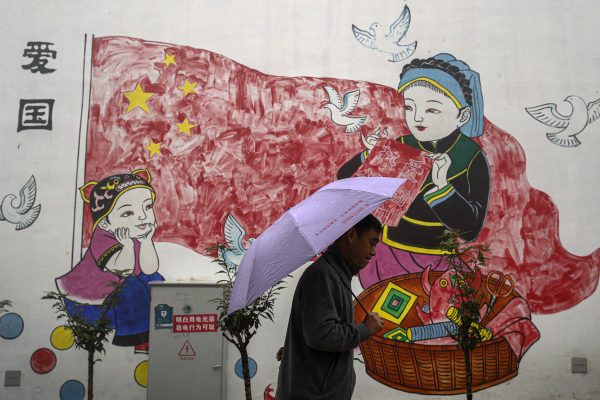
The shifts in ethnic policy go well beyond Xinjiang. This is fundamental rethink of how the CCP manages ethnocultural diversity and its colonial possessions.
A man holding an umbrella walks by a new village house decorated with a patriotic painting which was built by the Chinese government for ethnic minority members in Ganluo county, southwest China’s Sichuan province on Sept. 10, 2020.
In January, the U.S. State Department declared that the Chinese Communist Party (CCP) was committing ongoing genocide against the Uyghurs and other ethnic and religious minority groups in the Xinjiang Uyghur Autonomous Region, something later echoed by the new Biden administration. Subsequently, the Canadian, Dutch, and British parliaments passed non-binding resolutions designating China’s actions a genocide, with calls for other governments to follow suit.
In March, the Newlines Institute for Strategic and Policy issued a lengthy report detailing how the Chinese government’s actions in Xinjiang violate all five of the enumerated acts of genocide in the United Nations’ 1948 Convention on the Prevention and Punishment of the Crime of Genocide, including “mass deaths.”
There’s little doubt China’s pernicious repression of Uyghurs and other Indigenous people is a crime against humanity and human dignity. Yet these charges of genocide misdiagnose the problem and moreover distract us from understanding and ultimately holding the Chinese government accountable for the wider pattern of abuse occurring inside the People’s Republic of China (PRC).
Aspects of China’s new policy direction are certainly destructive, yet their colonial intent ultimately seeks to transform – not exterminate – the physical and social landscape of Xinjiang and other peripheral regions under the government’s control. They work to actively alter the thoughts and behaviors of what Chinese authorities perceive to be a “backward,” “deviant,” and innately “dangerous” sub-section of its population by uplifting their “bio-quality” (suzhi, 素质) and overseeing their rebirth as loyal, patriotic, and civilized Chinese citizens.
Debating the legal semantics of what is happening in Xinjiang is important. But we cannot allow it to distract us from how Xi Jinping and the CCP are turbo-charging the transformative resolve behind significant policy innovations across their colonial possessions – from Kashgar to Hong Kong and Lhasa to Hohhot.
Taming Xinjiang
In the dying days of the Qing dynasty, the Chinese state sought to colonize Xinjiang and other parts of its imperial frontier through Han resettlement. This program of settler colonialism continued following the establishment of the Chinese Republic and intensified as state power grew in the post-Mao era, eventually attracting more than 10 million Han settlers to Xinjiang and sparking cycles of Indigenous resistance.
Diplomat Brief Weekly Newsletter N Get briefed on the story of the week, and developing stories to watch across the Asia-Pacific. Get the Newsletter
Settler colonialism adopts what Patrick Wolfe calls the logic of elimination: not only the dissolution of native societies but also their expropriation through regimes of biocultural assimilation. In short, settler colonialism involves both effacement and replacement, and does not necessarily align with commonly accepted definitions of genocide.
As Xi came to power in late 2012, violent resistance escalated once again in Xinjiang, with a spate of deadly attacks across China. In response, he announced a “people’s war on terror” and called on Xinjiang authorities to show “absolutely no mercy.”






